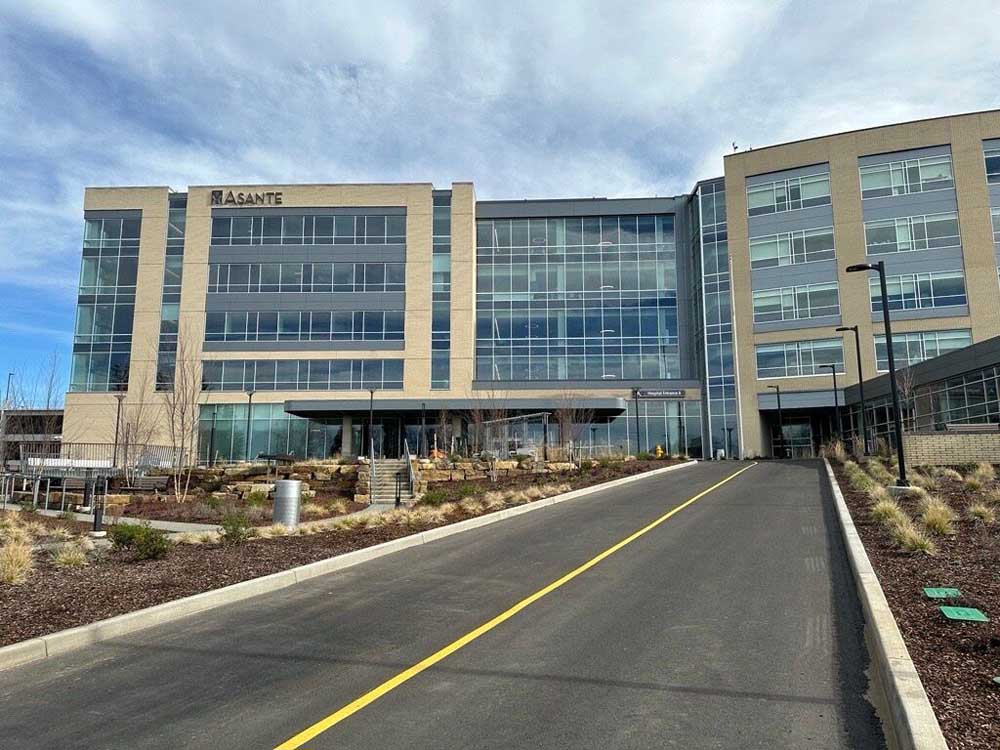Asante leads state in community benefit spending among hospital systems
Published 6:00 am Friday, February 9, 2024

- Asante Rogue Regional Medical Center's new patient pavilion houses the new Binette Family Birth Center within the Olsrud Family Women's and Children's Hospital, which opened at the start of last month.
Southern Oregon hospitals in 2022 spent more than ever before on community benefit spending, particularly in the form of unreimbursed Medicaid payments.
At the same time, Medford hospitals spent the least they ever had on patient financial assistance, according to a new report on hospital community benefit spending issued by the Oregon Health Authority.
Asante Rogue Regional Medical Center in Medford spent $121.1 million in community benefit spending on unreimbursed care and direct spending on programs to improve community health in fiscal year 2022, up 47.8% from the year before, according to the Oregon Hospital Community Benefit report issued late last month.
Providence Medford Medical Center that same year spent $36 million, up 12.5% from the year before.
The local numbers were in line with hospitals across the state, according to OHA hospital policy advisor Steven Ranzoni, who manages the hospital reporting program. Statewide, hospital community benefit spending jumped 21.7% to $2.2 billion in 2022, the highest year-over-year jump since the state began collecting data in 2010.
“The experience in Southern Oregon is not that dissimilar from the rest of the state,” Ranzoni said.
Other local hospitals saw community benefit spending that far surpassed the statewide growth rate.
Ashland Community Hospital spent $3.8 million on community benefit spending in 2022, up 52% from the year before, and the most community benefit spending since the hospital joined the Asante Health System in 2013. Three Rivers Medical Center in Grants Pass spent $52.1 million, up 70.2% from the year before.
The new OHA report tracks data on hospital and hospital system community benefit spending “floor” data. As required since 2019 by Oregon House Bill 3076, nonprofit hospitals must spend an assigned community benefit spending floor, or minimum, in lieu of taxes.
In terms of how much Asante spent in community benefit spending across its hospital system — Rogue Regional Medical Center in Medford, Three Rivers Medical Center in Grants Pass and Ashland Community Hospital — compared to the amount it was required to pay, the local health care provider led the state.
Asante spent a combined $177 million in community benefit spending — 202.3% of the $85.7 million floor that the OHA assigned it. No other regional health system in the state crossed the 200-percent mark, according to the data.
Asante did not return an emailed request for comment. Rogue Regional is at the center of multiple investigations into allegations of “drug diversion”: A former employee is alleged to have swapped out pharmaceutical fentanyl in IV bags with non-sterile tap water, harming patients.
Providence Health & Services was required to pay a minimum of $259.5 million across its nine hospitals, including Providence Medford Medical Center. Providence ranked fourth in the percentage rankings, spending $326.3 million in 2022, or 125.8% its assigned amount.
Slotting between the two local health systems in the rankings was Salem Health System at 154.4%, PeaceHealth in Lane County at 151.2% and Legacy Health at 127.9%.
Asante community benefit spending across its hospital system rose 53.9% from the prior year. Providence across its hospital system rose 1.2%.
Calculating the community benefit minimum spending floor involves a complex formula that involves the hospital’s past three years of unreimbursed care, its direct spending, patient revenue and operating margins, according to the OHA.
All but three hospitals in Oregon met at least their community benefit spending floor in 2022. The three exceptions: Curry General Hospital in Gold Beach, which spent 57.8% of the roughly $800,000 it was assigned; Saint Alphonsus Medical Center in Ontario, which spent 83.1% of the $6 million it was assigned; and Samaritan Lebanon Community Hospital, which spent 98.4% of the $8.4 million it was assigned.
Data going back to 2013 show the two numbers to be lows for both Medford hospitals in terms of percentages and dollar amounts. Unreimbursed Medicaid costs made up the bulk of both hospitals’ expenses: 48% at Rogue Regional and 73% at Providence Medford Medical Center.
The bulk of Asante’s community benefit spending came from the hospital system’s $85.8 million in unreimbursed Medicaid costs, roughly 48% of its total spending. Subsidized health services, described as expenses incurred operating necessary healthcare services at a loss, was $52.2 million, about 30%. And “other public program,” support for programs such as TRICARE and Veterans Health Administration, was $20.1 million, or 11%.
OHA data for local hospitals showed higher-than-ever unreimbursed Medicaid spending and lower-than-ever hospital financial aid, classified as “charity care” in the report.
Unreimbursed Medicaid expenses at Rogue Regional Medical Center were $57.9 million in 2022, or 48% of its community benefit spending total. The number is up 16.9% from the year before. At Providence Medford Medical Center, unreimbursed Medicaid expenses that same year made up 73% of community benefit spending, up 24.5% from the $21.5 million in 2021.
Charity care spending
Rogue Regional Medical Center spent $3.6 million on charity care in 2022, roughly 3% of the Medford hospital’s community benefit spending. And Providence Medford Medical Center spent $3.8 million on charity care, about 11% of community benefit spending.
The two hospitals’ charity care numbers to be lows for both Medford hospitals in terms of both percentages and dollar amounts, data from the previous decade shows.
Charity care at Rogue Regional Medical Center fell 10% from the year before and has been gradually declining since 2017, when charity care was $5.3 million, or 10%, of the hospital’s community benefit spending. The high point for Rogue Regional Medical Center over the past decade, according to historical data, was $13.2 million in charity care recorded in 2013. Providence recorded a similar high in 2013 of $11.1 million, or 50%, of its community benefit spending.
Ashland Community Hospital spent $564,700 on charity care in 2022, 15% of its $3.6 million community benefit spending. The charity care amount is near the low set in 2015 of $554,200 and nearly half the high of $949,600 set in 2013, prior to the hospital joining the Asante health system.
Statewide, hospital financial assistance grew, but only slightly, by 1.7%. Ranzoni said Oregon law has clear statutes regarding charity care, so there are defined requirements for how a hospital accommodates a charity-care patient.
He attributed the relatively unchanged charity care numbers in part to the Affordable Care Act and low-income patients having access to expanded Medicaid services under the Oregon Health Plan.
“Oregon is an expansion state in Medicaid, so we cover a larger amount of people than other states that have healthcare service,” Ranzoni said. “That works to try to move dollars out of what would be charity care and relocate it into Medicaid.”






